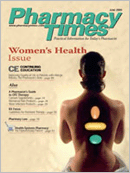Publication
Article
Pharmacy Times
Update on Management of Urinary Incontinence
Author(s):
Urinary incontinence (UI), a disorderthat involves an involuntaryloss of urine, has bothmedical and psychological consequences.1,2 Worldwide, it is estimatedthat >200 million people suffer fromUI, with more than 12 million peopleaffected in the United States.3,4 Womenare twice as likely as men to experiencethe condition, and the prevalence ofUI increases with age.4 In the UnitedStates, the annual expenditure ondirect costs alone was estimated at $16billion in 1995.5 UI is socially limitingand potentially embarrassing forpatients, so it is underreported tohealth care providers.6
Types of UI
UI is classified as either acute orchronic. Acute UI can be caused byacute medical problems such as infections(cystitis), delirium, diabetes, orcongestive heart failure.7 It also can becaused by prescription medicationssuch as diuretics or neuroleptics.7Nonprescription drugs, herbal supplements,and dietary components (eg,caffeine, artificial sweeteners) canincrease diuresis and exacerbate UI.Once the cause of the acute UI hasbeen treated or removed, normal continencegenerally is restored.
There are several types of chronic UI:stress, urge, mixed, overflow, or functionalincontinence.
•Stress incontinence is the loss ofurine following an increase inabdominal pressure or stress, suchas increased physical activity,coughing, or sneezing; this type ischaracterized by the loss of smallamounts of urine, with little or nonocturia8
•Urge incontinence occurs whenthe urge to urinate precedes theinvoluntary loss of urine by a relativelyshort time (a few seconds tominutes); the sudden urge to urinatedoes not allow the patient toreach the bathroom in time, andlarge amounts of urine may be lost9
•Mixed incontinence is a combinationof stress and urge incontinence
•Overflow incontinence occurswhen the bladder becomes distendedto the point where it canno longer resist urine outflow;patients may complain of urinaryhesitancy and experience the lossof small amounts of urine constantlythroughout the day7
•Functional incontinence occurs inpatients who are unable to reachthe commode to void; they may bephysically restrained, sedated bymedications, or cognitively impairedso that they are unaware that theyneed to urinate7
Nonpharmacologic Managementof UI
A full medical history and physicalexamination should be conductedbefore starting treatment so as to fullyelucidate the type of UI. Nonpharmacologictherapies should be attemptedas first-line treatment options in allpatients, because these therapies havebeen shown to be as effective or moreeffective than pharmacologic options.8Kegel exercises and bladder trainingallow patients to manage their incontinenceand to reduce the number ofvoiding accidents.8 It is also very usefulto explain the common symptomsof UI and how to manage them withbehavior modifications (frequent toileting)and personal care hygieneproducts.
Pharmacologic Management of UI
Normal micturition occurs when themuscular layer surrounding the bladder,the detrusor muscle, contracts incoordination with relaxation of thesphincters of the bladder neck.Detrusor muscle contraction is primarilymediated by cholinergic stimulationof muscarinic receptors on thebladder smooth muscle. Anticholinergicagents antagonize muscarinicreceptors, resulting in a relaxation ofthe bladder smooth muscle, and aretherefore useful for urge incontinence.1
Oxybutynin chloride is a commonlyused anticholinergic agent that targetsthe M2 and M3 receptors. It is availablein immediate-release (Ditropan), extended-release (Ditropan XL), andtransdermal (Oxytrol) formulations.The side effects are dose-related andinclude dry mouth, constipation, andblurred vision. Patients may favor theXL formulation because it is associatedwith less dry mouth.
The transdermal formulation of oxybutyninis applied twice weekly (every3-4 days) to dry, intact skin on theabdomen, hip, or buttock. It is importantto rotate sites and to avoid usingthe same application site within 7days. The patch is more expensive butalso is associated with less dry mouththan the immediate-release formulation.10 Common adverse reactions withthe patch include pruritis and applicationsite erythema, as well as drymouth.
Tolterodine tartrate (Detrol) isanother anticholinergic agent used totreat UI. It has a greater affinity forM2 receptors in the bladder versus thesalivary glands, resulting in lowerrates of dry mouth. Tolterodine hasboth immediate-and extendedreleaseformulations, with the latterpreferred because of lower rates ofanticholinergic side effects. Whencomparing oxybutynin with tolterodine,oxybutynin has been shown tobe more effective but to produce moreside effects.11
Tricyclic antidepressants such asamitriptyline or nortriptyline also maybe used to treat UI due to their anticholinergicside effects. They are, however,not first-line agents because theyproduce central nervous system (CNS)and cardiovascular side effects.
A number of new agents are availablefor UI. Trospium chloride(Sanctura) is a muscarinic receptorantagonist that is dosed once daily onan empty stomach. Trospium doesnot have CNS side effects due to itsquaternary amine structure, whichdoes not permit it to cross the bloodbrainbarrier.12 This attribute makes itfavorable for elderly patients who areat risk for cognitive impairment secondaryto anticholinergic medications.
Solifenacin succinate (VESIcare) isanother newly approved drug for UI. Itis a nonselective muscarinic antagonistthat is selective for the bladder.9,12Solifenacin is dosed once daily andmay be given with or without food.12
Darifenacin (Enablex) is a selectiveM3 receptor antagonist that came onthe market in 2004. Although it has ahigher affinity for the bladder than forthe salivary glands, the clinical implicationsof the dry-mouth effect are notyet fully understood.9,12 Darifenacin isdosed once daily and should not becrushed or chewed.12
Patient Counseling
When patients start medicationtherapy, it is essential to explain howeach medication is administered andto inform them of the common sideeffects they may experience such as drymouth, constipation, or drowsiness.Information regarding crushing ofmedications and cost is also valuableto patients because it may influencewhich product would suit them better.Caregivers for elderly patients alsoshould be reminded to watch for signsof altered mental status when startinganticholinergic agents.
In addition, it is important to encouragenonpharmacologic optionssuch as Kegel exercises and bladdertraining along with adherence to medicationtherapy. Finally, follow-upwith patients is necessary to monitortheir response to drug therapy. If medicaltherapy is not providing any benefitor if side effects are dose-limiting,the patient should be referred to aurology specialist for a more extensiveworkup.
Dr. Hajjar is an assistant professor of clinicalpharmacy at the University of the Sciences inPhiladelphia, Philadelphia College ofPharmacy.
For a list of references, send astamped, self-addressed envelope to:References Department, Attn. A. Stahl,Pharmacy Times, 241 Forsgate Drive,Jamesburg, NJ 08831; or send an e-mailrequest to: [email protected].







